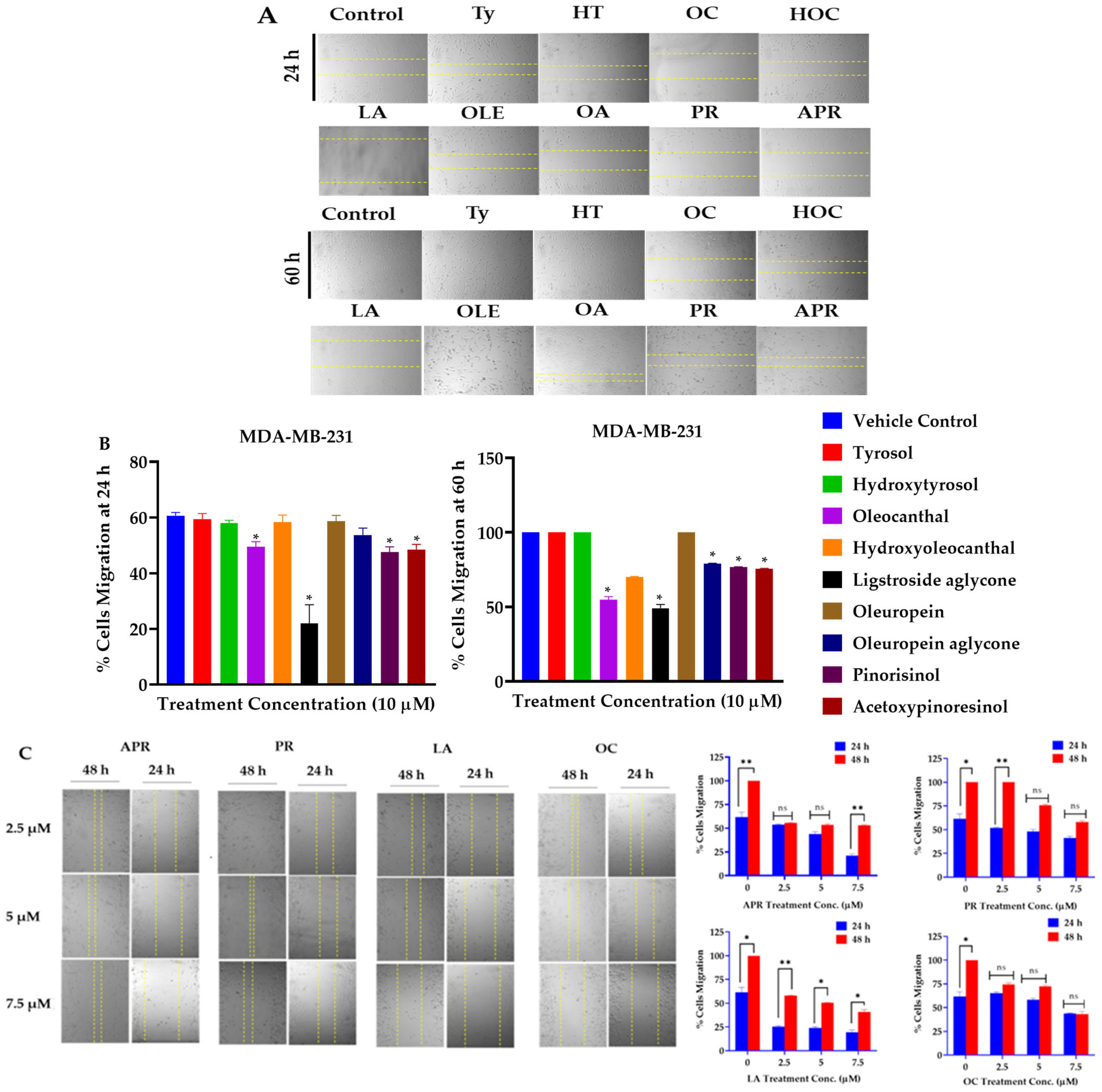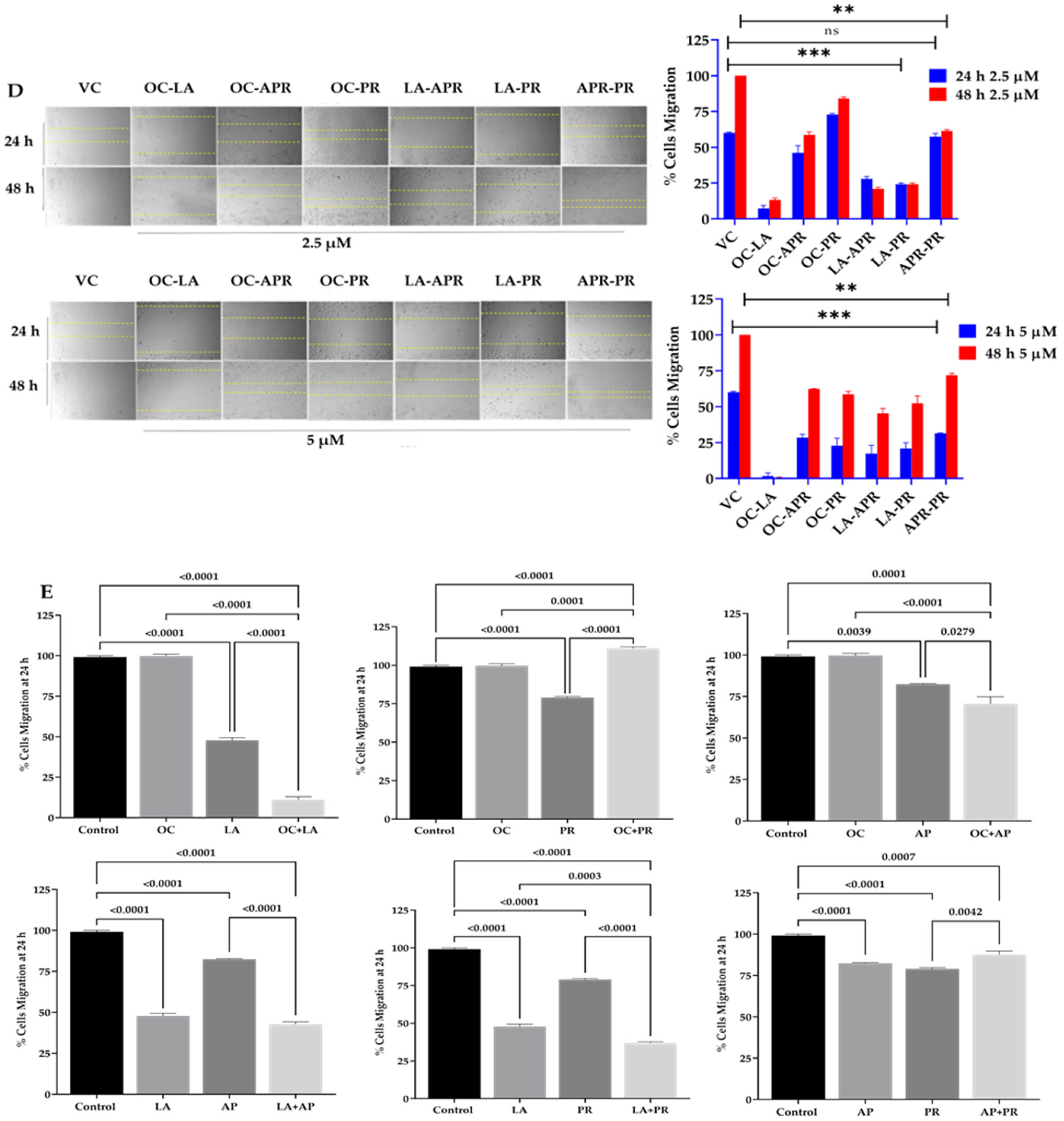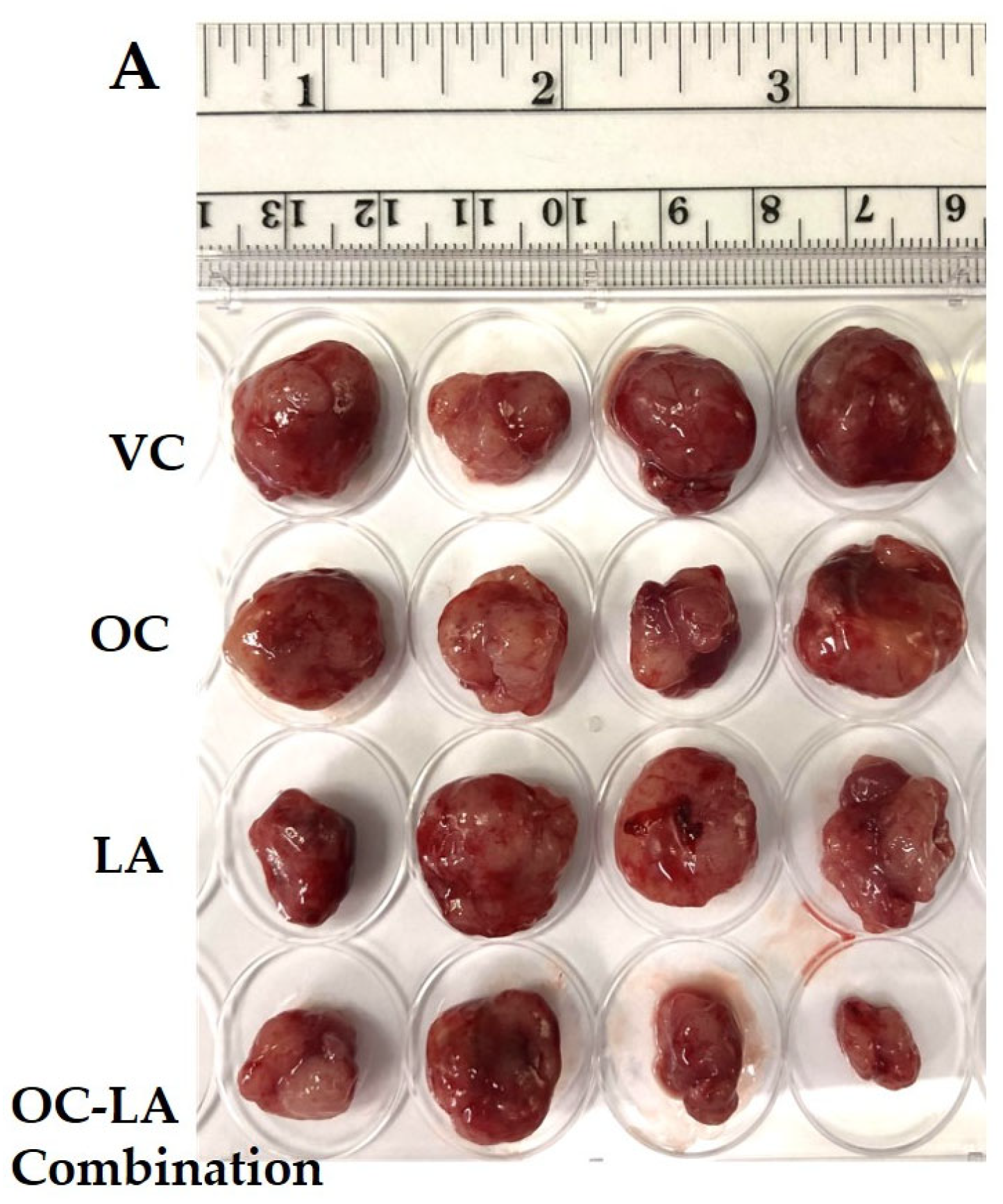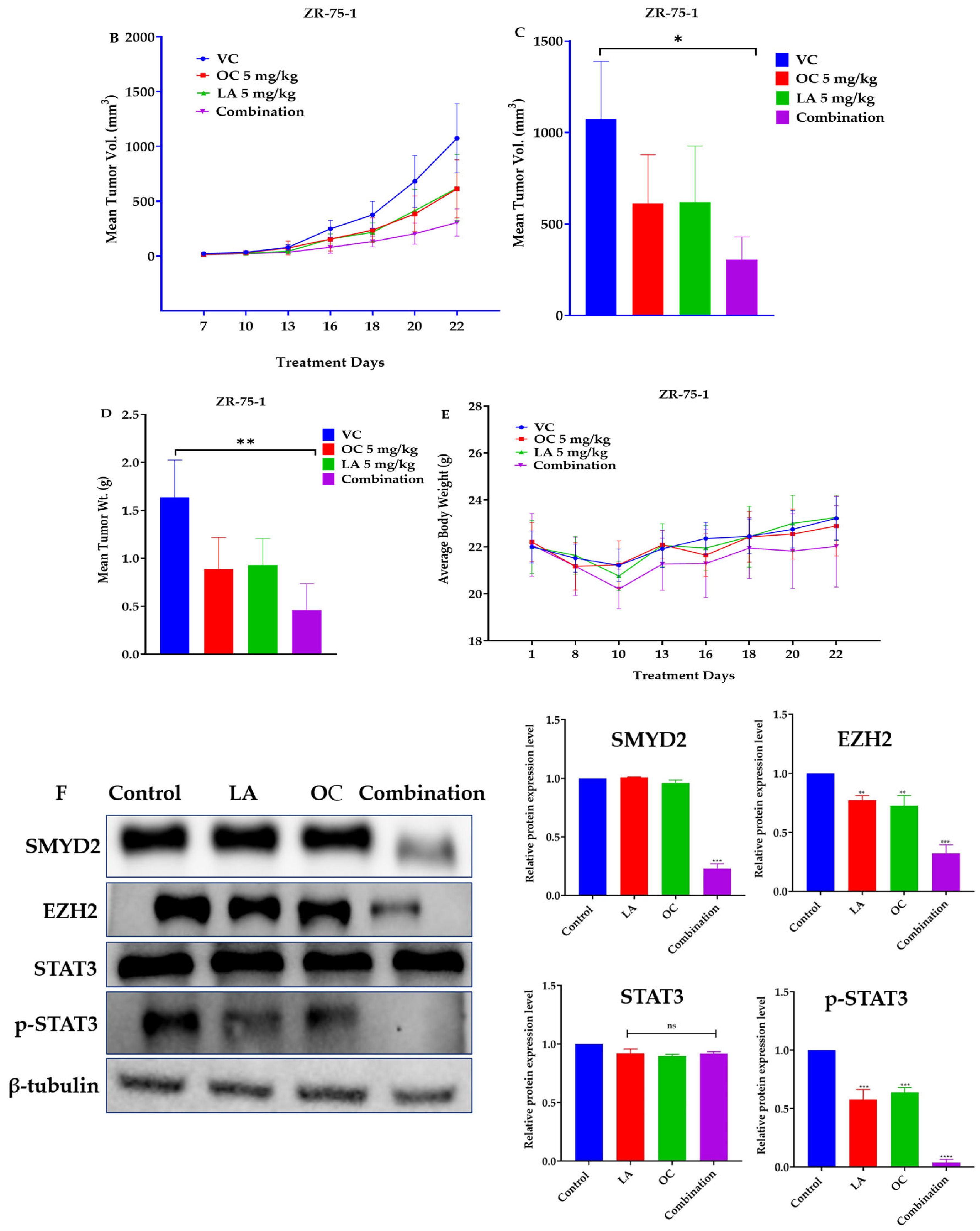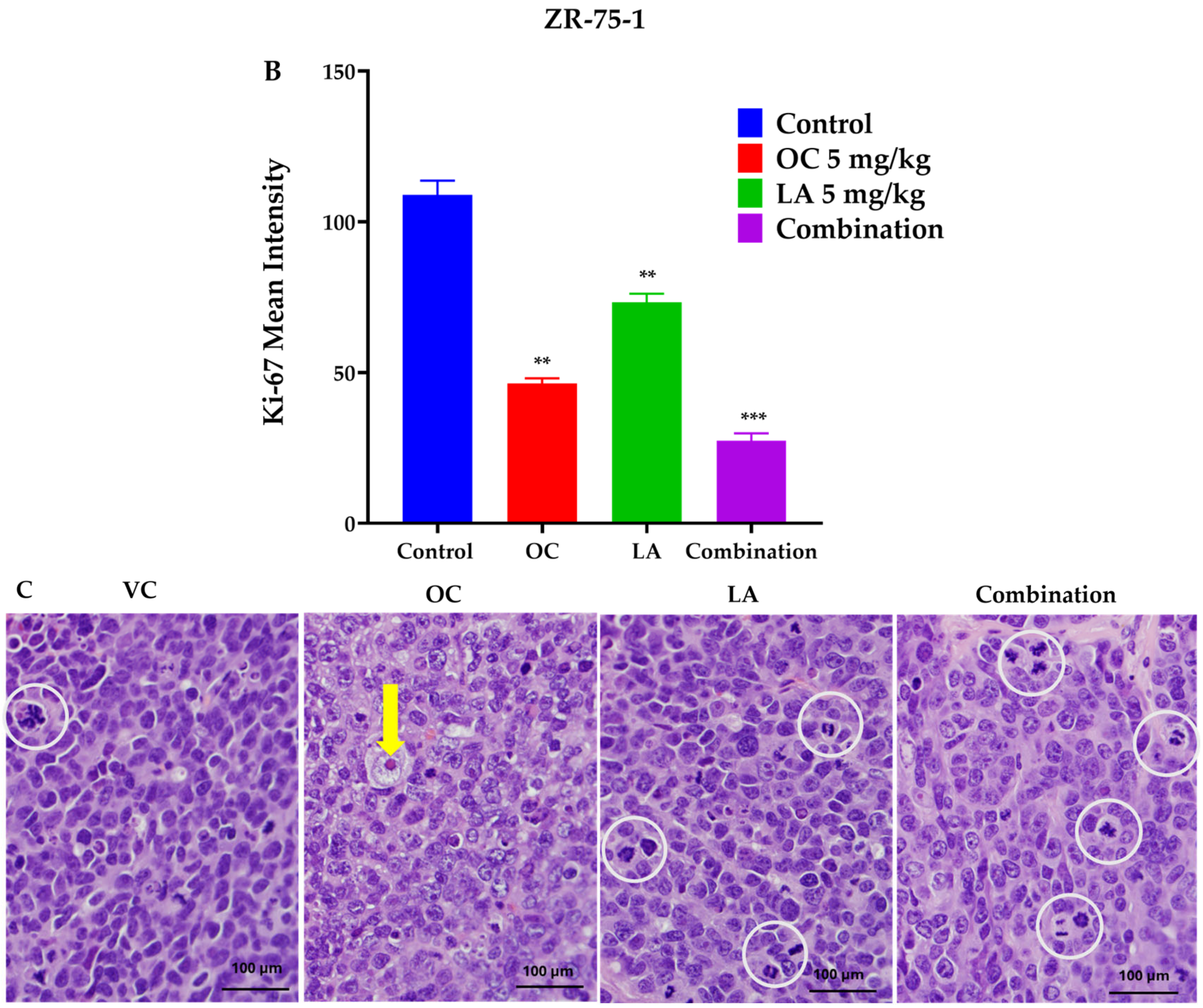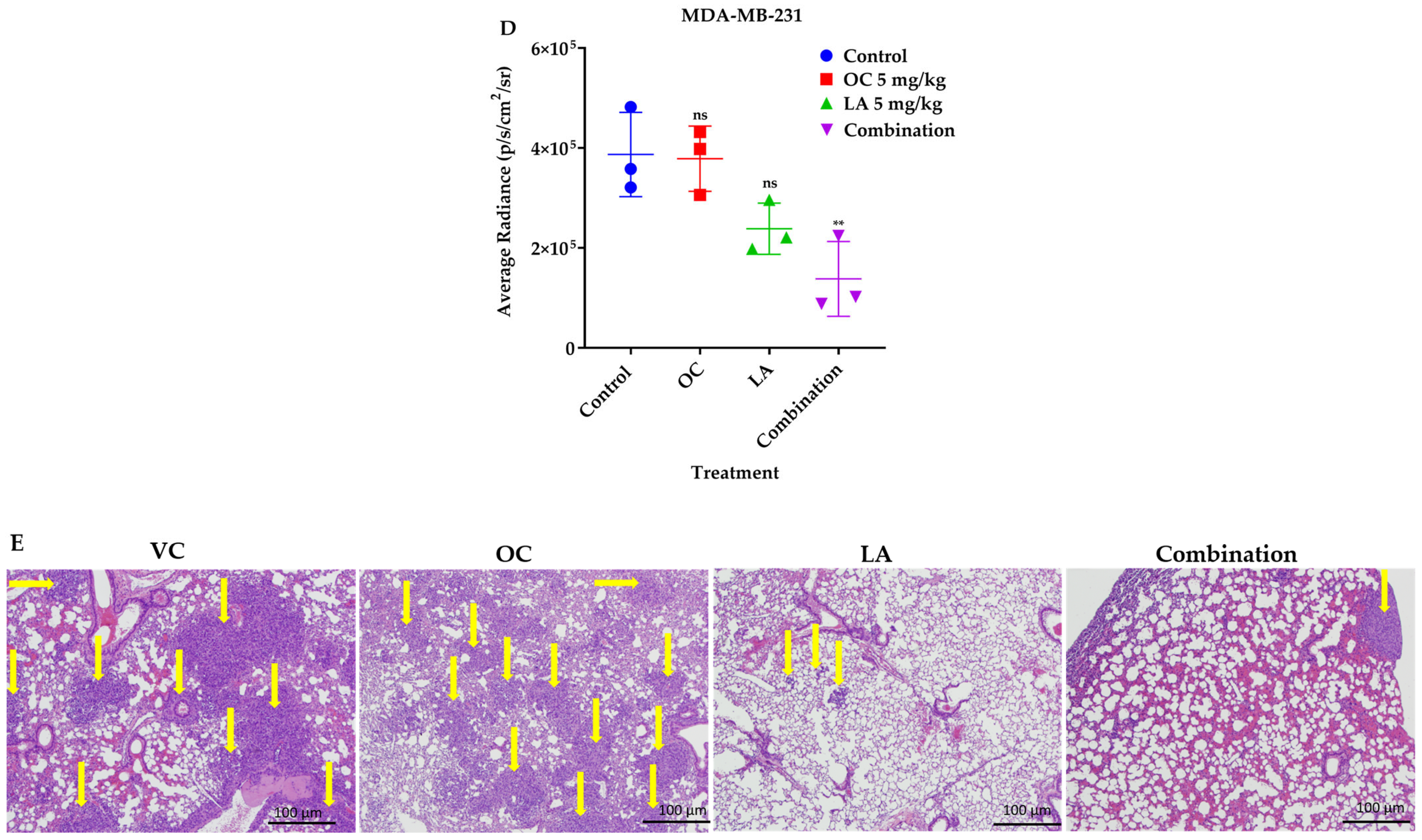1. Introduction
Breast cancer (BC) is the most commonly diagnosed malignancy among females and the second leading cause of cancer-related mortalities in women worldwide. According to statistics, 316,950 estimated new BC cases and 42,170 deaths are expected in the United States this year [
1]. A group of manageable and non-manageable factors contributes to the increased risk of developing BC. Manageable risk factors are changeable or avoidable and include obesity, sedentary lifestyle, and exposure to exogenous hormones, while hereditary predisposition and aging are among the non-manageable factors that are non-avoidable [
2]. BC is a heterogeneous disease that is classified to four main subtypes: luminal A (ER
+ and/or PR
+/HER2
−/low Ki-67), luminal B (ER
+ and/or PR
+/HER2
+/high Ki-67), non-luminal HER2
+ (ER
− and PR
−/HER2 overexpressed), and triple negative BC (TNBC, ER
−, PR
−, HER2
−) [
3]. Current therapeutic strategies include surgical intervention, radiation, chemotherapies (taxanes, anthracyclines, and platinum-based), hormonal therapy (selective estrogen receptor modulators, SERMs), aromatase inhibitors, targeted therapies (tyrosine kinase inhibitors), in addition to immunotherapies (immune checkpoint inhibitors and monoclonal antibodies) [
4,
5]. However, these therapeutic options induce severe off-target effects, fail to prevent recurrence, and develop rapid resistance via altered signaling pathways like upregulating the PI3K (phosphatidylinositol 3-kinase), mTOR (mammalian target of rapamycin), and Ras-ERK (extracellular signal-regulated kinase) signaling pathways [
6]. Thus, there is a dire need to discover new effective BC therapeutic alternatives.
The SMYD2, SET, and MYND domain-containing protein 2, a lysine methyltransferase, is aberrantly dysregulated in different cancer types, inducing several mitogenic signaling pathways by methylating lysine moieties, activating multiple oncogenic and effector proteins [
7,
8]. SMYD2 methylates several histone H3K4 and H3K36 and non-histone mitogenic proteins in BC, together with p53, Rb, HSP90, PTEN, and estrogen receptor-α (ERα) [
9]. SMYD2 contributes to the progression of TNBC by methylating and activating non-histone protein targets, specifically STAT3 and NF-κB, while also methylating histone substrate proteins, regulating the transcription of numerous BC-associated genes [
10,
11]. Moreover, the enhancer of zeste 2 polycomb repressive complex 2 subunit (EZH2) is a downstream SMYD2 protein substrate and assumed among the top lysine methyltransferases significantly upregulated in metastatic BC cells [
11,
12]. SMYD2-mediated EZH2 di-methylation at lysine 307 (K307) activates and elevates its stability, which can be demethylated by the histone H3K4 lysine-specific demethylase 1 (LSD1) in BC [
11,
12,
13]. EZH2-K307 dimethylation promotes the proliferation and invasion of BC cells through facilitating the recruitment of EZH2 to chromatin remodeling and the subsequent transcriptional repression of EZH2 target genes [
12]. EZH2 non-canonically methylates STAT3, promoting its nuclear localization [
13]. This leads to an overexpression of genes that drive BC proliferation and migration, advancing the progression [
13].
The Mediterranean diet (MD) is one of the most widely recognized and extensively studied dietary patterns globally [
14,
15,
16]. MD reflects the traditional high consumption of non-starchy vegetables, seeds, nuts, minimally processed whole grains, legumes, and olive oil, and moderate consumption of dairy products and alcohol, as well as low meat intake [
14,
15]. Epidemiological studies established the positive impact of sticking to the MD on overall human health, including cardiovascular health, obesity, and a lower incidence of various types of cancer, diabetes, and dyslipidemia [
16,
17]. Prospective studies have shown that MD can lower overall mortality and has been linked to a slower progression of age-related cognitive decline and a reduced risk of certain malignancies [
17,
18]. Extra-virgin olive oil (EVOO) is one of the hallmark ingredients of the MD [
19,
20]. The health benefits of EVOO are attributed to its high content of monounsaturated fatty acids, which can constitute up to 80% of its total fats [
20,
21]. However, studies indicated that EVOO’s minor phenolic compounds are key players in various health benefits attributed to EVOO consumption [
20,
21]. EVOO phenolics are grouped into five categories: phenolic acids, alcohols, secoiridoids, lignans, and flavones [
21].
S-(−)-Oleocanthal (OC) was initially isolated by the Montedoro group from EVOO and was later identified by the Beauchamp group as the potent nonsteroidal anti-inflammatory EVOO ingredient with comparable ibuprofen-like cyclooxygenases (COXs) inhibitory activity [
22,
23]. OC demonstrated antioxidant and neuroprotective properties, showing positive outcomes in cellular and animal models of Alzheimer’s disease by reducing Aβ-amyloid fibrils and accumulation of neurofibrillary tangles in the brain, and suppressed complement component 3a receptor 1 activity [
24]. Furthermore, OC exhibited anti-inflammatory effects by reducing IL-6 expression and inhibiting the release of 5-lipoxygenase [
24]. OC showed potential anticancer effects in various cellular and animal models [
25]. OC suppressed hepatocellular carcinoma growth and metastasis by inactivating STAT3 both in vitro and in vivo [
26]. OC had also been reported to inhibit mesenchymal-epithelial transition factor (c-MET) receptor tyrosine kinase and its downstream signaling pathways, reducing the activation of the mechanistic target of rapamycin (mTOR) levels, and suppressing COX-2 expression in different cancer types [
27]. Previously, this study team validated OC as an effective modulator for the ER expression and function in hormone-dependent BC, in both in vitro and in vivo models [
28]. OC showed a similar ER binding mode and revealed synergistic effects when combined with the selective ER modulator tamoxifen [
28]. The same team also showed that OC significantly synergized with the dual EGFR-HER2 antagonist lapatinib using both in vitro and in vivo model systems of hormone-dependent luminal B BC [
29]. A significant TNBC progression suppression was recorded in a nude mouse orthotopic xenograft model upon oral administration of OC nano-emulsion [
30]. OC nano-emulsion was selectively in vitro cytotoxic to BC cells but showed modest effects on the viability of the non-tumorigenic mammary epithelial cells MCF-10A [
30]. OC effectively suppressed the luminal B BC (BT-474 cells) and TNBC (MDA-MB-231 cells) locoregional recurrence after primary tumor surgical excision in nude mouse xenograft models [
31]. A recent study explored the synergy of EVOO phenolics double combinations and crude occurrence in extracted EVOO samples for potential suppression of the proliferation of diverse cancers [
32]. Among the discovered most active combinations was the improved anti-luminal A BC activity of an EVOO sample rich in LA and oleuropein aglycone (OA), exceeding the OC and hydroxyoleocanthal (oleacein, HOC) level. This LA-OA-rich EVOO sample inhibited the luminal BC cell line MCF-7 cells’ viability by 50% at 14.8–22.9 µg/mL LA+OA [
32]. This activity level was >25-fold higher than the previously reported EC
50 values (~500 µg/mL) for multiple EVOO total phenolic extracts rich in LA and OA against the MCF-7 BC cell line [
32].
Based on the epidemiological studies, promising anticancer outcomes correlating the regular consumption of EVOO with improved human health, and the documented positive anti-BC results of OC, the present study aims at comprehensive in vitro screening of a small olive phenolics library for luminal A BC growth and TNBC migration suppression, followed by selecting the most in vitro active hits for subsequent TNBC anti-metastatic and luminal A progression suppression in vivo activities individually and in combinations. Combination studies can guide future selection of the best EVOO varieties for potential translational nutraceutical use by BC patients and survivors to control their disease and prevent its relapse.
3. Discussion
Therapeutic approaches targeting luminal A BC and TNBC face distinct challenges due to their divergent molecular profiles [
2,
3]. Luminal A tumors often develop resistance to hormonal therapies over time, limiting the long-term efficacy of targeted therapies. In contrast, TNBC lacks expression of estrogen, progesterone, and HER2 receptors, eliminating the targeted therapies option and leaving chemotherapy as the main intervention option [
4]. Chemotherapies have high toxicities, develop rapid resistance, and sometimes have a limited therapeutic response [
4]. Furthermore, TNBC is highly heterogeneous, complicating intervention drug development; hence, discovery of new alternative therapeutics addressing these challenges is a high priority.
Data acquired from the TCGA database showed the overexpression of SMYD2, STAT3, and EZH2 among BC subtypes, highlighting their potential contributions to BC pathogenesis. Their consistent upregulation in luminal and HER2
+ BC, TNBC, as well as in other cancers, highlights their relevance as explicit oncogenic drivers. SMYD2 and EZH2 showed the most significant dysregulation, indicating their particular importance for BC progression. Screening of a small library of nine EVOO phenolics identified OC, LA, and HOC with moderate cytotoxic effects against BC. Several BC phenotypes also tend to invade, migrate, and metastasize to the surrounding and distant sites [
39]. Thus, limiting BC motility is an utmost therapeutic goal. Combination studies for OC and LA reduced BC cells viability in a dose-dependent manner. Individually, LA showed better BC cells viability-suppressing potency versus OC. OC and LA showed a strong synergistic effect against both ZR-75-1 and MDA-MB-231 cells viability. A CI value of <1 indicated a synergistic effect, and a DRI value >1 validated the enhanced anti-BC efficacy at much reduced OC-LA doses. DRI values > 1 are advantageous because this demonstrates that the compound achieves therapeutic efficacy at much lower individual compound concentrations, reducing the risk for potential off-target effects. Identification of synergistic activity of EVOO phenolics at lower concentrations can translationally be applied to select the OC-LA-rich EVOO varieties for use by BC patients and survivors.
Comparison of the LA and OC antiproliferative activity against a panel of chemo- and targeted therapies shows that, although PTX demonstrated superior activity on BC cells viability compared to OC in the MTT assay, OC remains a promising entity for invasive BC, either alone or combined with other entities, due to its superior selectivity to malignant cells versus non-tumorigenic cells, potent activities against cancer motility-invasion assays, favorable safety profile, absence of neuropathic side effects unlike taxanes, and high in vivo oral anti-BC potency. The combination of LA and OC at 5 µM, which is a subtoxic concentration, significantly inhibited MDA-MB-231 cells migration and invasion, confirming their pharmacological antimigratory and anti-invasive effects. The 5 µM treatment concentration for each of LA and OC is a physiologically relevant concentration that can mimic the low natural abundance of both EVOO phenolics in the commercial quality EVOO brands. LA and OC combination treatments showed a significant inhibition for the MDA-MB-231 cells migration over the 24 h treatment period compared to individual 5 µM of each of LA, OC, and VC-treated cells.
Clonogenicity assays showed a synergistic effect for the LA-OC combination against both ZR-75-1 and MDA-MB-231 BC cell lines. LA-OC combination treatment likely restrained tumor cells motility without causing direct cytotoxicity or affecting cells’ viability. The clonogenicity assay is based on the ability of a single tumor cell to adhere and form a subsequent viable colony. This in vitro experimental model resembles the in vivo distant recurrence/metastasis process in which the circulating tumor cell adheres to a distant preferential organ with a proper microenvironment, favoring and promoting this adherence (organotropism), forming a colony and developing subsequent metastatic foci [
38]. The colony formation assay model is the in vitro mimic of the nude mouse tail vein-metastasis in vivo model used in this study.
The LA-OC combination synergistically reduced tumor volume and weight in the ZR-75-1 xenograft model, achieving a significant tumor progression suppression. Furthermore, no significant body weight changes were observed, suggesting a plausible favorable safety profile. These results support the potential of OC and LA in combination, as promising therapeutic nutraceutical candidates for luminal A BC. SMYD2-EZH2 were recently documented as molecular targets for OC in prostate and colorectal cancers [
40]. Both lysine methyltransferases have been validated as critical molecular targets in many cancers, including BC [
10,
11,
12,
13,
41,
42]. STAT3 proved to be a SMYD2 downstream tyrosine kinase substrate and OC molecular target [
10,
11,
12,
26,
43]. Western blot results clearly proved that the OC-LA combination was effective in synergistically reducing SMYD2-EZH2-p-STAT3 expression levels in the luminal A ZR-75-1 invasive BC. The lysine methyltransferase SMYD2 was reported to methylate EZH2 at lysine 307 (K307), which promotes BC cells proliferation, EMT, and invasion [
42,
43,
44]. Moreover, EZH2 promotes BC by directly methylating and activating STAT3 as a post-transcriptional modification [
13]. STAT3 activation by EZH2 is crucial for BC improved cells survival, proliferation, and migration [
13]. Collectively, the combined EVOO phenolics OC-LA proved effective in suppressing luminal A BC progression by targeting the SMYD2–EZH2–STAT3 axis. The OC-LA combination notably suppressed Ki-67 expression, confirming its enhanced antiproliferative activity in BC. Histological examination revealed increased fibrosis and tumor necrosis in the combination-treated group, indicating enhanced therapeutic effects. These findings reinforce the synergistic efficacy of OC and LA in targeting tumor progression at both molecular and tissue levels.
OC was previously tested in female nude mouse xenograft and transgenic mouse models for BC progression and recurrence, but never tested for antimetastatic activity [
27,
28,
29]. The in vivo antimetastatic effect of the LA-OC combination was assessed in a female nude mouse tail vein model using TNBC MDA-MB-231-Luc cells. Results revealed a remarkable controlled cancer dissemination exerted by LA-OC combination treatments. Inevitably, this model should show the highest tumor cells clonogenicity in the animal lungs, since the iv-injected tumor cells will circulate within the blood stream to reach the lungs, which offer favorable tumor microenvironment [
45]. Thus, this model is an ideal mimic for in vivo clonogenicity. The regular-standard in vivo OC therapeutic dose in nude mouse models is usually 10 mg/kg [
27,
28,
29,
31,
40]. The selection of the low 5 mg/kg subeffective dose in this study was intended to mimic the low natural occurrence of these phenolics in EVOO. Translationally, the human equivalent dose (HED) for the 5 mg/kg used in this study in mice can be calculated as follows: HED mg/kg = Animal dose (mg/kg) x K
m ratio = 0.41 mg/kg in humans [
46]. The correction factor K
m is the ratio of the average body weight (kg) to body surface area (m
2). K
m is constant for each species. The K
m value for mice is 3 and for humans is 37 [
46]. Thus, a daily intake of 0.41 mg/kg OC by a human with an average body weight of 70 kg will translate to a total of 28.7 mg, which can match the used dose in this study. This dose is physiologically realistic, considering the use of a daily intake of 28.7 mL phenolics-rich EVOO, which can normally contain up to 1000 mg OC/L. Microenvironments that interface tumor cells and specific organs play a vital role in organ-specific metastasis. Circulating tumor cells travel to distant organs, where they initiate new tumors when the microenvironment is favorable for subsequent clonogenicity [
45,
47,
48]. The LA-OC combination markedly suppressed lung metastases, highlighting its potential to limit BC spread. Immunofluorescence confirmed significant inhibition of Ki-67 and CD31, indicating reduced proliferation and endothelial vasculogenesis. These findings support the combination’s anti-metastatic and anti-angiogenic efficacy in vivo.
OC has never been tested in clinical trials as a pure entity [
49]. The 13 hits for OC on Clinicaltrials.gov show OC-rich EVOO or combination testing [
49]. OC-rich EVOO was tested in chronic lymphocytic leukemia by Rojas 2022, NCT04215367 [
50]. This study did not use pure OC but used EVOO-rich in OC [
50]. Patients used for 9 months daily oral 40 mL EVOO containing either 416 mg/L OC + 284 mg/L HOC or 82 mg/L OC + 33 mg/L HOC [
50]. This translates to the highest patient total OC daily intake of 16.6 mg, which translates to 0.24 mg/kg for a 70 kg average body weight patient. A study conduced in Greece (NCT04520126) used a 3:1:2 OC–hydroxytyrosol–oleuropein combination for cardiovascular–endothelial function [
49]. Other clinical trials reported the use of EVOO-nutraceutical combinations for metabolic, cardiovascular, gut–brain axis, multiple sclerosis, neurofibromatosis, or cognitive diseases [
49]. This study’s results and literature studies indicate the near-future clinical promise for OC and LA for testing to control BC in humans. The main translational limitation of EVOO use as a source for useful anti-BC nutraceuticals is the erratic natural occurrence of various EVOO phenolics, including OC and LA. Their natural occurrence in EVOO is based on diverse factors, including genetic origin, environment, collection time, handling, malaxation, and several other factors. Standardized EVOO with known specific OC and LA levels can address this challenge and facilitate patients selection of the best EVOO varieties for prospective nutraceutical use.
4. Materials and Methods
4.1. Chemicals and Reagents
All chemicals and reagents were purchased from Sigma-Aldrich (St. Louis, MO, USA), unless specified differently. Organic solvents were obtained from VWR (Suwanee, GA, USA), dried by standard procedures, packaged under nitrogen in Sure/Seal bottles, and stored over 4 Å molecular sieves, unless otherwise indicated. Antibodies were purchased from Cell Signaling Technology (Beverly, MA, USA), except where noted. Antibodies typically used at 1:1000 dilution unless otherwise noted. Cell culture reagents were purchased from Life Sciences (Carlsbad, CA, USA).
4.2. Extraction of Olive Phenolics from Extra-Virgin Olive Oil
The EVOO phenolics
S-(−)-Oleocanthal (OC),
S-(−)-hydroxyoleocanthal (HOC), tyrosol (TY), hydroxytyrosol (HT),
S-ligstroside aglycone (LA),
S-(−)-oleuropein aglycone (OA), (+)-pinoresinol (PR), and (+)-1-acetoxypinoresinol (APR) were isolated from Greek EVOO collected batches in the fall of 2020 and fall of 2021 (The Governor, Corfu, Greece). Separation of EVOO phenolic compounds was performed using an in-house-developed novel liquid–liquid extraction methodology, partitioning EVOO with deionized water, entrapping phenolics on Sorbtech, Sepabeads Resin Styrenic Adsorbent Sp-70-01 entrapment resin (Sorbent Technologies, Norcross, GA, USA), eluting phenolics with acetone, followed by size exclusion chromatography of dried acetone extract on Sephadex LH20, using CH
2Cl
2-EtOAc careful gradient elution [
30]. The identity and purity of olive phenolics were validated by q
1H NMR analysis using a JEOL JNM-ECZL400S FT-NMR system with Delta™ processing software (version 6.3, Peabody, MA, USA) and high-resolution mass spectrometric analysis using a JEOL JMS-T100LP AccuTOF LC-plus instrument (Peabody, MA, USA), confirming >99% purity for each tested olive phenolic [
30]. Spectroscopic identity was based on extensive 1D and 2D NMR analyses and comparison with literature values, especially the chemical shift of LA protons H-3 (δ 7.59, singlet) and H-8 (δ 9.57, broad singlet) [
22,
30]. The quantitation of OC purity was based on the integration ratio of the OC key H-3 aldehydic proton signal at δ 9.23 and the residual CHCl
3 peak in the CDCl
3 at δ 7.24 [
30]. The 99% purity EVOO phenolic samples were stored frozen in amber glass vials under N
2 gas [
30].
S-(−)-oleuropein was extracted from commercial olive leaf extract capsules, 50% standardized oleuropein content (Nusapure
®, Amazon, Seattle, WA, USA), extracted with MeOH, and the remaining residue after defatting with
n-hexanes was size-exclusion-chromatographed on Sephadex LH20, using CH
2Cl
2-MeOH gradient elution [
48].
4.3. Cell Lines and Culture Conditions
Human BC cell line ZR-75-1 (ER-positive luminal A) was obtained from Charles River Laboratories, Inc. (Wilmington, MA, USA), while the human luciferase-tagged TNBC cell line MDA-MB-231-Luc was purchased from GenTarget Inc. (San Diego, CA, USA). Cells were cultured in Roswell Park Memorial Institute (RPMI-1640) provided with 10% fetal bovine serum (FBS), penicillin G (100 U/mL), streptomycin (100 ng/mL), and sodium pyruvate (100 ng/mL). All cells were maintained in a humidified incubator at 37 °C with 5% CO2. For sub-culturing, cells were washed with Ca2+- and Mg2+-free phosphate-buffered saline (PBS) and incubated in 0.05% trypsin containing 0.02% Ethylenediaminetetraacetic acid (EDTA) in PBS for 5–15 min at 37 °C.
4.4. Tumor Cells Proliferation Assay
MDA-MB-231 and ZR-75-1 cells were plated in 96-well plates at a density of 1 × 104 cells per well and incubated overnight at 37 °C in a 5% CO2 humidified incubator for attachment. The next day, treatment working solutions were prepared in DMSO, and multiple different concentrations of treatments were added to the wells in triplicate, then cells were incubated at 37 °C for 48 h. Media were gently aspirated. About 100 μL of fresh media and 100 μL of MTT solution were added to each well, and cells were incubated for an additional 3 h. Media were carefully removed, and formazan crystals were dissolved in DMSO. Optical density was measured at 570 nm using a Synergy 2 microplate reader (BioTek, 242 Winooski, VT, USA). Cells number deduced from a standard curve performed at the beginning of each experiment. The IC50 values were calculated using GraphPad Prism version 8.01 (GraphPad Software, San Diego, CA, USA). Experiments were conducted in triplicate to confirm reproducibility and statistical significance.
4.5. Wound-Healing Scratch Assay
MDA-MB-231 cells were seeded in 24-well plates at a density of 5 × 103 cells/well and incubated overnight for attachment at 37 °C in a 5% CO2 humidified incubator. Wounds were then scratched using sterile 200 μL pipette tips. Cells were repeatedly rinsed with PBS and re-incubated in 1% serum media containing different treatment concentrations from a 10 mM stock solution in DMSO and DMSO as VC. Wound images were captured at zero time and monitored for wound closure up to 24 h. When wounds were about to close, the media were removed, and cells were washed with cold PBS and fixed with ice-cold MeOH, stained with Giemsa stain. Finally, wound images were taken for treatment and VC groups using a Nikon Ti2-A Inverted Intelligent microscope (Nikon Instruments Inc., Melville, NY, USA). The percentages of each treatment’s cell migration were calculated using the following formula: Percent cell migration = [T0 − Tt − Tdmso]/[T0 − Tdmso] × 100, where T0 is wound thickness at zero time, Tdmso is the wound thickness in DMSO-treated control wells, and Tt is the wound thickness in treatment wells. Experiments were performed in triplicate to ensure reproducibility and statistical significance.
4.6. Transwell Migration Assay
The Radius™ 96-Well Cell Migration Assay kit was used (Cell BioLabs, San Diego, CA, USA). MDA-MB-231 cells were cultured in each well’s upper chamber (5 × 105 cells/well), containing either VC or individual phenolics (OC or LA) in a concentration of 5 µM each or combination of both treatments in a concentration of 5 µM. Aliquots of 10% FBS serum- media were supplemented to each lower chamber well as a chemoattractant. After 24 h, all chambers were washed with PBS and fixed with ice-cold MeOH for 10 min, then stained with Giemsa stain. Finally, chambers were photographed using an inverted Nikon microscope. Results were expressed as the percentage of migration and normalized to VC, which assumed 100% migration. Assays were executed in triplicate to ensure reproducibility and statistical significance.
4.7. Invasion Assay
The BD BioCoat™ BD Matrigel™ Invasion kit (BD Biosciences, San Diego, CA, USA) was used. MDA-MB-231 cells were seeded in each upper chamber (5 × 105 cells/well) and precoated with Matrigel with either the VC or individual phenolics (OC or LA) in concentrations of 5 µM each or combination of both treatments in a concentration of 5 µM. Aliquots of 10% serum-containing media were added to the lower chambers as chemoattractant. After 24 h, all the chambers were rinsed with PBS and fixed with ice-cold MeOH for 10 min, then stained with Giemsa stain. Finally, an inverted Nikon microscope (Nikon Instruments Inc., Melville, NY, USA) was used to capture images of the chambers. Results were expressed as the percentage migration normalized to the VC, which assumed 100% migration. Experiments were performed in triplicate to ensure reproducibility and statistical significance.
4.8. Colony Formation Assay
ZR-75-1 and MDA-MB-231 cells were seeded in 12-well plates at a density of 1 × 103 per well, incubated for 3 days till attachment and differentiation at 37 °C in a 5% CO2 humidified incubator. Cells were assigned into VC, individual phenolics (OC or LA) in concentrations of 5 µM each, and a combination of both treatments in a concentration of 5 µM in 1% serum media from a 10 mM stock solution in DMSO. Media with treatments were changed every other day for a 12-day incubation period. At the end of the experiment, media were aspirated, colonies washed with cold PBS, fixed with ice-cold MeOH, and stained with Giemsa stain. Images were captured using a digital camera, and colonies were manually counted. Experiments were repeated three times to ensure reproducibility and statistical significance.
4.9. Animal Models and Treatment Modes
Female athymic nude mice (Foxn1nu/Foxn1+, aged 5–6 weeks) were obtained from Envigo (Indianapolis, IN, USA). The mice were maintained at the University of Louisiana at Monroe (ULM) vivarium animal facility. Animals were housed in filter-top cages with Alpha-Dri bedding in a clean room environment, provided with free access to food and water. The cages were placed on ventilated racks equipped with high-efficiency particulate air (HEPA) filtration. Environmental conditions were controlled at 25 °C, 55–65% relative humidity, with a 12 h light/dark cycle. Animal experiments were approved by the Institutional Animal Care and Use Committee (IACUC), with the protocol number 19 NOV-KES-01. All experiments were performed in strict accordance–compliance with the NIH-guided good animal practices. Animal welfare and experimental protocols were strictly followed to minimize discomfort and distress to the mice throughout the study course.
4.9.1. Orthotopic Nude Mice Xenograft Tumor Model
Approximately 5 × 106 cells of the ER+ luminal A BC cell line ZR-75-1 suspended in Matrigel/RPMI-1640 were injected subcutaneously into the mouse mammary fat pad. Once the tumors became palpable, reaching an average 30–50 mm3 volume (nearly 14 days post xenografting), mice were randomly assigned into 4 groups, 4 mice per group: VC (sterile PBS), OC individual treatment group (5 mg/kg, ip, 3X/week), LA individual treatment group (5 mg/kg, ip, 3X/week), and a combination of both OC and LA (5 mg/kg, each, ip, 3X/week). Dosing continued over a period of 3 weeks. Tumor volume was measured using the standard formula: tumor volume (mm3) = [(length × width2)/2]. Animals were monitored for body weight changes and any signs of treatment- or vehicle-related toxicity. Animals were sacrificed at the end of the study, and tumors were collected and kept at −80 °C for subsequent analysis.
4.9.2. Tail Vein Nude Mice Xenograft Tumor Model
The TNBC MDA-MB-231-Luc luciferase-labelled cells, approximately 1 × 10
6 cells in sterile PBS, were xenografted intravenously into the tail veins of the female nude mice. Bioluminescence was measured by imaging 2% isoflurane anesthetized mice using an IVIS Lumina series III (Perkin Elmer, Waltham, MA, USA) imaging system after intraperitoneally (ip) injecting with D-luciferin (XenoLight D-luciferin K
+ salt bioluminescent Substrate, PerkinElmer) at a dose of 75 mg/kg per animal in sterile PBS [
44]. The photons emitted from luciferase-expressing cells within the animal body and transmitted through the tissue were quantified using the Living Image software program (PerkinElmer, Version 4.7.3, PerkinElmer, Waltham, MA, USA). Images representing bioluminescence intensity (blue, least intense, and red, most intense) were generated and quantified as photons/second. Mice were randomly assigned into 4 groups of 4 mice in each group: VC (sterile PBS), OC monotherapy treatment group (5 mg/kg), LA monotherapy treatment group (5 mg/kg), and a combination of both OC and LA (5 mg/kg, each). Dosing immediately started post xenografting intraperitoneally (ip), 3X/week for 6 weeks. Animals were imaged and bioluminescence was recorded once a week to monitor the tumor clonogenicity at each mouse’s lungs. The animals’ health was monitored routinely for clinical or behavioral changes, weight loss, or any signs of altered motor ability. At the study end, mice were sacrificed according to the approved IACUC protocol, and bioluminescence images of each mouse’s whole body and collected organs (lung, brain, liver, spleen, heart, and kidney) were captured, then immediately fixed in 10% neutral buffered formalin for 48 h. The tissues were further transferred to 70% ethanol for further analysis.
4.10. Immunohistochemistry (IHC) Study
The IHC slides, 5 μm thick sections acquired at AML Laboratories (Jacksonville, FL, USA), were made from paraffin-embedded tumor tissue samples of the ZR-75-1 xenograft tumor model and the MDA-MB-231-Luc metastatic foci at animal lung tissue sections. IHC protocol briefly started with the de-paraffinization in xylene and graded ethanol, sections were boiled in citrate buffer for 20 min, then permeabilized in TBST solution for 15 min at 25 °C. Then, sections were stained with the primary antibodies of Ki67 (Cat #9129, 1:200, Cell Signaling, Boston, MA, USA) or CD-31 (Cat #3528, 1:200, Cell Signaling) and diluted in blocking solution for 24 h at 4 °C. Next day, sections were rinsed and stained with secondary antibodies for 1 h. At the end of the experiment, images were captured at the Research Core Facility, LSUHSC, Shreveport, LA, USA, in 10× magnification power using an Olympus iXplore CSU W1 spinning disk confocal microscope (Center Valley, PA, USA). Experiments were performed in triplicate to ensure reproducibility and statistical significance.
4.11. Hematoxylin and Eosin Y (H&E) Staining
Tumor samples were fixed in 10% neutral buffered formalin for 48 h, transferred to 70% ethanol, and then paraffin-embedded. Paraffin-embedded tumor blocks were sectioned into 5 µm sections utilizing a Leica RM2035 microtome by AML Laboratories (Augustine, FL, USA). Sections were fixed on positively charged slides, xylene dewaxed, rinsed with alcohol, rehydrated in water; finally, slides were stained with H&E [
29].
4.12. Analysis of Clinical SMYD2, STAT3 and EZH2 Genes Expression Data
The TCGA gene expression data were analyzed using UALCAN, which is a publicly available web tool able to perform in-depth analysis [
33,
34,
35,
36,
37]. The mRNA expression patterns of SMYD2, STAT3, and EZH2 were analyzed. The gene expression profiling interactive analysis (GEPIA) was used to explore RNA sequence expression difference between normal and cancer samples [
37]. GEPIA was used for differential expression analysis comparison of SMYD2, STAT3, and EZH2 in various cancers versus normal organ tissues [
37].
4.13. Western Blot Analysis
Collected ZR-75-1 tumor samples were weighed, and total protein contents were extracted in RIPA lysis buffer (Thermo Fisher Scientific, Madison, WI, USA), supplemented with mammalian protease arrest (G-Biosciences, St. Louis, MO, USA), and were homogenized using an ultrasonic homogenizer (Qsonica Sonicator, Newtown, CT, USA). Homogenates were incubated at 4 °C for 4 h, then centrifuged for 15 min at 14,000× g, and supernatants were stored at −80 °C. The protein concentration was assessed by the Pierce BCA Protein Assay (Bio-Rad, Hercules, CA, USA). Lysates were loaded as 15 µg tumor lysate. Proteins were electrophoresed on Mini-PROTEAN TGX precast polyacrylamide gels (BIO-RAD) using Tris/glycine/SDS running buffer and transferred to Immuno-Blot PVDF membranes (BIO-RAD). Blotted membranes were blocked with 5% BSA (Cell Signaling Technology, Beverly, MA, USA) in TBST (10 mM Tris-HCl, 150 mM NaCl, 0.1% Tween-20) for 2 h with gentle rocking at rt. Immunoblots were incubated overnight at 4 °C with appropriate primary antibodies (Cell Signaling Technology). After incubation, the membranes were washed 5 times with TBST and then probed with HRP-labeled secondary antibodies (Cell Signaling Technology) for 1 h with agitation at rt, followed by rinsing 5 times with TBST. Proteins were detected using the ChemiDoc XRS chemiluminescent gel imaging system and analyzed using Image Lab software (Version 5.2.1, Bio-RAD, Hercules, CA, USA). All experiments were performed in triplicate, and β-tubulin was used as a housekeeping protein to confirm equal sample loading in all lanes.
4.14. Statistical Analysis
Data analysis was performed using GraphPad Prism software, version 8.0.2. (La Jolla, CA, USA). Results were presented as mean ± standard error of the mean (SEM) for continuous variables. Differences among various treatments and control groups in the animal study were determined using ordinary One-way ANOVA, followed by the post hoc Dunnett’s multiple comparisons test. A difference of *
p < 0.05 was considered statistically significant, where: (*
p < 0.05, **
p < 0.01, ***
p < 0.001, and ****
p < 0.0001). Combination data were analyzed, and results showed combination index (CI) values according to the median-effect principle, where CI < 1, =1, and >1 indicate synergism, additive effect, and antagonism, respectively [
28,
38]. CI values calculated as follows: CI = [Xc/X + Tc/T], where X and T stand for the concentrations of individual combination ingredients, OC and LA, that induced 50% cell growth inhibition (IC
50); Xc and Tc are the concentrations of combination ingredients that induce 50% cell growth inhibition when used combined as determined by non-linear regression curve fit analysis [
28,
38].

